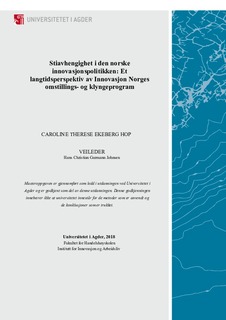| dc.description.abstract | Norwegian business is now facing extensive international competition and external pressure.
This means that it has become more important than ever to have network and expertise
available, which can contribute to a solid competitive edge. It is important for the public
sector to keep up with the development of business in society. At the same time, there is a
lack of resources and many statutory tasks, which can define their scope for innovation and
development. This affects particularly smaller peripheral municipalities. It has also become
very important for companies to think about knowledge development and co-creation in order
to develop and ensure continued existence in a labour market with extensive competition. In
order to remedy this, Innovation Norway, in cooperation with the Ministry of Local
Government and Regional Development (Ministry of Local Government and Modernization),
has developed a restructuring program and, in consultation with the Research Council and
Siva, a cluster program.
In this assignment I want to look at the change processes and programming. It is important to
show that the institutions of society are formally divided into two categories in Norway,
depending on the type of group or organization they are a part of. This means the public
direction and the more business-oriented. This is interpreted from a social constructivist view,
where structural features like opinions and relevant practices are created through institutional
objects. This master's thesis is about Innovation Norway, which is the program owner for the
Restructuring Program and the Cluster Program. The latter is managed as mentioned in
consultation with Siva and the Research Council. Restructuring and change characterizes both
the public and the private sector nationally, regionally and locally. These are common
features within isomorphism, but also different interpretations as a result of different contexts.
This means that emphasis is placed on Innovation Norway's ability and willingness to adapt to
changes that occur continuously from the ministries, the municipality and the clusters.
It is the understanding of program learning that in this historical context looks at whether the
development of the programs contains knowledge and change of understanding (Gustavsen,
2008). Innovation Norway has chosen to continue and implement knowledge and skills from
the restructuring program into another program for clusters, where it is considered whether
there are common features or not for the programs and whether they affect each other. It is
seen the problem of originality in the form of innovation policy is evaluated. This means that
it is planned to carry out restructuring and innovation in the public and private sector today. I have chosen to use the theoretical method of qualitative input as the basis for my master's
thesis. Good and reasonable use of knowledge and expertise is what contributes to good
restructuring and future value creation within the Norwegian economy.
The restructuring program is a national program developed around 1980, as a direct result of
major closures and changes over time. The purpose of the restructuring program is to assist
municipalities and regions with external resources. It is being made to develop and add skills
they are not in possession of or have the ability to realize themselves. The program is a
collaboration between Innovation Norway, the county authorities and program participants.
The cluster program has been established later in 2002 and is a foreign concept. It will be a
national program aimed at strengthening and developing knowledge, expertise and innovation
in regions, but also nationally and globally.
The restructuring program and the cluster program overlap each other within some areas of
knowledge and competence. This applies mainly to the framework of the programs. It is the
ministries that get the new radical ideas from abroad that lead to innovation. Then they are
implemented into Innovation Norway. The indication is that learning effects within
Innovation Norway concentrate on incremental changes as a result of, among other things,
feedback from program members. There is absorptive capacity in Innovation Norway that
leads to renewal or reinforcement. What will naturally be the next step, will be an analysis
and observation of the conversion program and the cluster program where program learning
becomes the main focus. Then one must take on innovation policy and assess a reassessment
or renewal in the public and private sectors that can contribute to self-improvement. | nb_NO |

